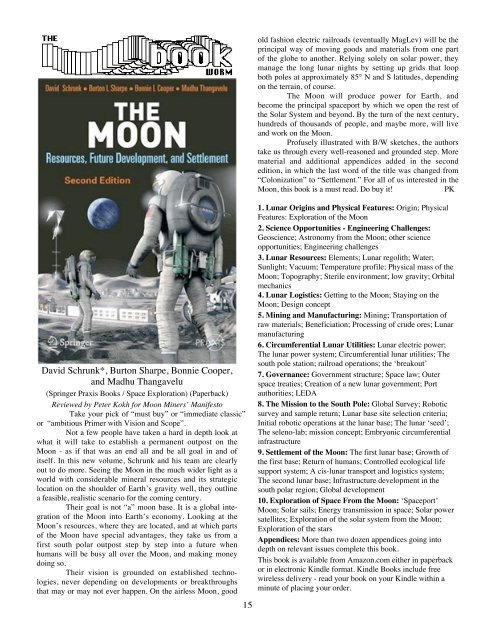Chandrayaan-1 Flies! Welcome to Moon Miners' Manifesto India ...
Chandrayaan-1 Flies! Welcome to Moon Miners' Manifesto India ...
Chandrayaan-1 Flies! Welcome to Moon Miners' Manifesto India ...
You also want an ePaper? Increase the reach of your titles
YUMPU automatically turns print PDFs into web optimized ePapers that Google loves.
David Schrunk*, Bur<strong>to</strong>n Sharpe, Bonnie Cooper,<br />
and Madhu Thangavelu<br />
(Springer Praxis Books / Space Exploration) (Paperback)<br />
Reviewed by Peter Kokh for <strong>Moon</strong> Miners’ Manifes<strong>to</strong><br />
Take your pick of “must buy” or “immediate classic”<br />
or “ambitious Primer with Vision and Scope”.<br />
Not a few people have taken a hard in depth look at<br />
what it will take <strong>to</strong> establish a permanent outpost on the<br />
<strong>Moon</strong> - as if that was an end all and be all goal in and of<br />
itself. In this new volume, Schrunk and his team are clearly<br />
out <strong>to</strong> do more. Seeing the <strong>Moon</strong> in the much wider light as a<br />
world with considerable mineral resources and its strategic<br />
location on the shoulder of Earth’s gravity well, they outline<br />
a feasible, realistic scenario for the coming century.<br />
Their goal is not “a” moon base. It is a global integration<br />
of the <strong>Moon</strong> in<strong>to</strong> Earth’s economy. Looking at the<br />
<strong>Moon</strong>’s resources, where they are located, and at which parts<br />
of the <strong>Moon</strong> have special advantages, they take us from a<br />
first south polar outpost step by step in<strong>to</strong> a future when<br />
humans will be busy all over the <strong>Moon</strong>, and making money<br />
doing so.<br />
Their vision is grounded on established technologies,<br />
never depending on developments or breakthroughs<br />
that may or may not ever happen. On the airless <strong>Moon</strong>, good<br />
15<br />
old fashion electric railroads (eventually MagLev) will be the<br />
principal way of moving goods and materials from one part<br />
of the globe <strong>to</strong> another. Relying solely on solar power, they<br />
manage the long lunar nights by setting up grids that loop<br />
both poles at approximately 85° N and S latitudes, depending<br />
on the terrain, of course.<br />
The <strong>Moon</strong> will produce power for Earth, and<br />
become the principal spaceport by which we open the rest of<br />
the Solar System and beyond. By the turn of the next century,<br />
hundreds of thousands of people, and maybe more, will live<br />
and work on the <strong>Moon</strong>.<br />
Profusely illustrated with B/W sketches, the authors<br />
take us through every well-reasoned and grounded step. More<br />
material and additional appendices added in the second<br />
edition, in which the last word of the title was changed from<br />
“Colonization” <strong>to</strong> “Settlement.” For all of us interested in the<br />
<strong>Moon</strong>, this book is a must read. Do buy it!<br />
PK<br />
1. Lunar Origins and Physical Features: Origin; Physical<br />
Features: Exploration of the <strong>Moon</strong><br />
2. Science Opportunities - Engineering Challenges:<br />
Geoscience; Astronomy from the <strong>Moon</strong>; other science<br />
opportunities; Engineering challenges<br />
3. Lunar Resources: Elements; Lunar regolith; Water;<br />
Sunlight; Vacuum; Temperature profile; Physical mass of the<br />
<strong>Moon</strong>; Topography; Sterile environment; low gravity; Orbital<br />
mechanics<br />
4. Lunar Logistics: Getting <strong>to</strong> the <strong>Moon</strong>; Staying on the<br />
<strong>Moon</strong>; Design concept<br />
5. Mining and Manufacturing: Mining; Transportation of<br />
raw materials; Beneficiation; Processing of crude ores; Lunar<br />
manufacturing<br />
6. Circumferential Lunar Utilities: Lunar electric power;<br />
The lunar power system; Circumferential lunar utilities; The<br />
south pole station; railroad operations; the ‘breakout’<br />
7. Governance: Government structure; Space law; Outer<br />
space treaties; Creation of a new lunar government; Port<br />
authorities; LEDA<br />
8. The Mission <strong>to</strong> the South Pole: Global Survey; Robotic<br />
survey and sample return; Lunar base site selection criteria;<br />
Initial robotic operations at the lunar base; The lunar ‘seed’;<br />
The seleno-lab; mission concept; Embryonic circumferential<br />
infrastructure<br />
9. Settlement of the <strong>Moon</strong>: The first lunar base; Growth of<br />
the first base; Return of humans; Controlled ecological life<br />
support system; A cis-lunar transport and logistics system;<br />
The second lunar base; Infrastructure development in the<br />
south polar region; Global development<br />
10. Exploration of Space From the <strong>Moon</strong>: ‘Spaceport’<br />
<strong>Moon</strong>; Solar sails; Energy transmission in space; Solar power<br />
satellites; Exploration of the solar system from the <strong>Moon</strong>;<br />
Exploration of the stars<br />
Appendices: More than two dozen appendices going in<strong>to</strong><br />
depth on relevant issues complete this book.<br />
This book is available from Amazon.com either in paperback<br />
or in electronic Kindle format. Kindle Books include free<br />
wireless delivery - read your book on your Kindle within a<br />
minute of placing your order.















